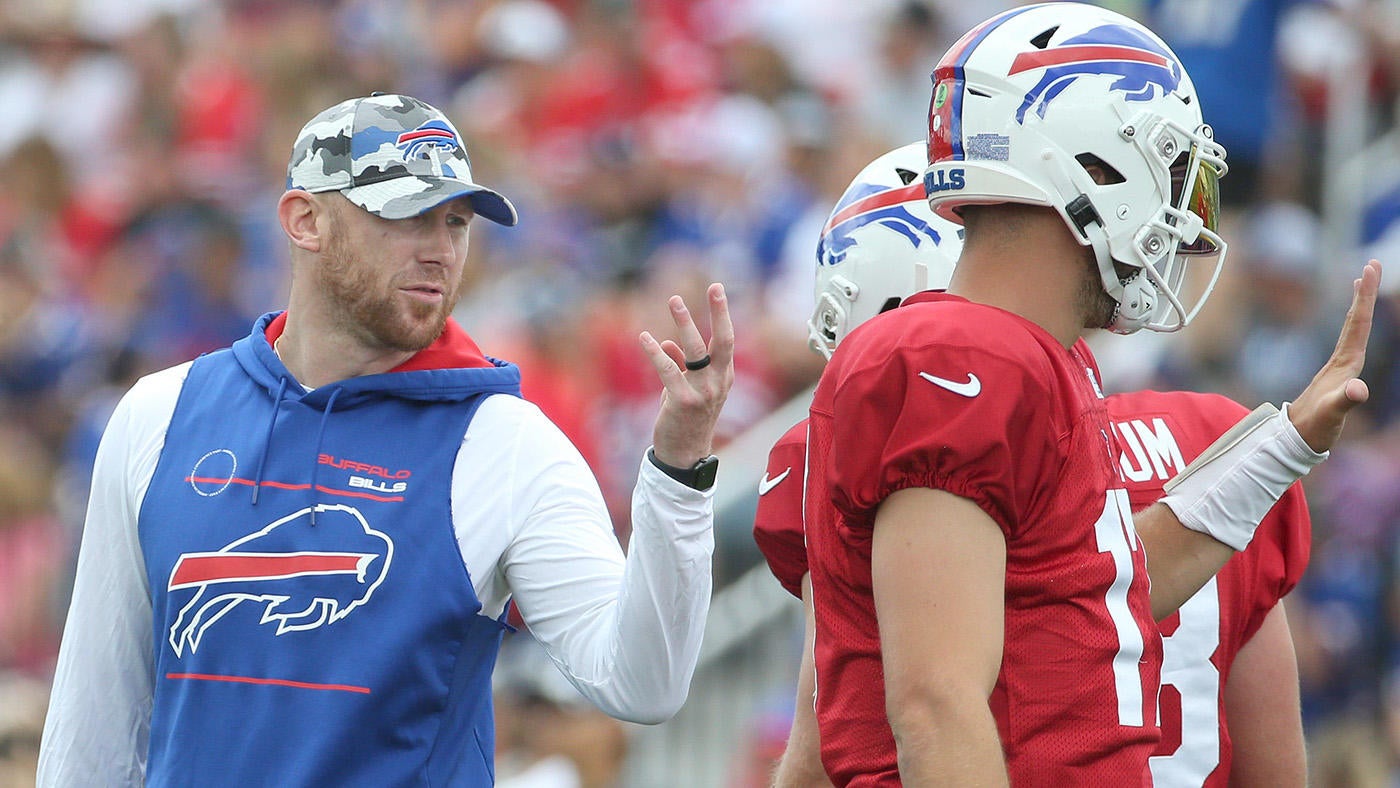Bills fire OC Ken Dorsey: What Buffalo can expect from new play-caller Joe Brady
Written by CBS SPORTS ALL RIGHTS RESERVED on November 15, 2023


The Buffalo Bills made a big change following their Monday night loss against the Denver Broncos, firing offensive coordinator Ken Dorsey. With Dorsey out, it’ll be 34-year-old former Panthers OC Joe Brady now sending plays into Josh Allen’s helmet for Buffalo.
Bills Mafia, that dots the United States, is wondering — what can be expected of the former QB coach-turned-Bills play-caller?
There’s a relatively small sample to evaluate, as Brady was part of a co-play calling tandem at LSU in 2019 and spent a season and a half in Carolina as the Panthers OC from 2020-2021. Those jobs came after he got his start in coaching as an offensive assistant under Sean Payton with the Saints for the 2016 and 2017 seasons.
Now 5-5, the Bills are desperate for a jolt, and the club clearly hopes Brady can be the one to energize the offense. Let’s dive into what Brady did running two offenses from 2019 to 2021.
(Because it was later reported Brady was fired 11 games into his second season as Panthers OC for calling fewer run plays than head coach Matt Rhule liked — despite the Panthers being extremely run heavy — I’ve only highlighted Brady’s first full season in Carolina for the sake of this article, as it appeared then he had full control of what the Panthers did offensively without head-coach meddling.)
Brady’s LSU tenure
Let’s start with Brady’s one-year stint as LSU’s pass game coordinator in 2019. He was hired to install the spread offense after his time in New Orleans under Payton. And dhile Steve Ensminger was the offensive coordinator, reading the tea leaves during that special season for the Tigers indicated Brady was essentially the program’s deputy offensive coordinator who was integral to game-plan creation and providing plays to Ensminger to be relayed to Joe Burrow onto the field that season.
In fact, before the national title game against Clemson, Ensminger gave a glimpse inside their shared play-calling duties in a 247 Sports article, saying:
Joe is better with our compact packages. Joe is better at our empty package than I am. So I tell him, we talk about it before the game, Look, when I want to go empty, be ready. If it’s third and whatever, and I have a call, I make it. If not, I tell him. He has it all highlighted. I’m like, Take it.
We can go to empty right now. I said, Joe, I’m going empty. Take it, he’s ready for it.
Compact meaning our bunch packages, a condensed formation, stuff like that. He’s better at that than I am. I know it. I tell him, Hey, I want to go whatever it is, bunch, pack ’em all in here. I said, Call it. He’s ready for it.
Football Scoop named Ensminger and Brady Offensive Coordinators of the Year in 2019.
Also, the following caveat is a must.
Brady had, arguably, the most luxurious quarterback/receiver-duo compilation in modern college football history with Joe Burrow throwing passes to Ja’Marr Chase and Justin Jefferson. That level of talent advantage over the defense does not exist on the Bills nor on any team in the NFL.
This article is only to examine Brady’s philosophies, tendencies etc. during the Tigers’ magical national-title winning season, and what it means for Josh Allen and Buffalo’s offense. Not attempting to insinuate anything more.
In 2019, Burrow used play action on 26.6% of his drop backs, the 50th-highest rate among 100 qualifying quarterbacks. Of his 617 drop backs, 50 of them were RPOs, which ranked 55th out of 200-plus qualifiers. Nothing overly play-action or RPO-happy about Brady’s offense that year.
But a whopping 94.9% of Burrow’s dropbacks in 2019 came in either “11” or “10” personnel, meaning LSU trotted out three or four receivers on almost every passing play. Smart, considering the presence of Chase, Jefferson and future second-round pick Terrace Marshall Jr.
Burrow had six of 15 contests with an average depth of target (aDOT) over 10.0 yards and finished the season with an aDOT of 9.6, which amounted to a reasonably high rank of 30th in all of college football, but it wasn’t as if Burrow ran a completely vertical-based aerial attack.
More generally, in neutral situations (score differential between -8 and +8 points), LSU dropped back to pass 65.2% of the time, the seventh-highest rate in all of FBS that season. The Tigers had a first-down, neutral-situation pass rate of 65.2% in 2019, the second highest in the nation.
With Burrow, Chase and Co. at LSU, the Tigers utilized motion on 34.2% of their dropbacks, the 29th-highest rate in college football (out of around 130 teams).
In short, Brady, who hand a key role in that offense with the title “pass game coordinator/wide receivers coach,” wanted to spread defenses out with three-plus receivers, use motion every third drop back on average and take to the air early and often.
Brady with Carolina Panthers
At the ripe age of 30, Brady was hired by the Panthers to run the Teddy Bridgewater, Christian McCaffrey, D.J. Moore led-offense in 2020 (he turned 31 late that September). How much of his LSU tendencies carried over?
That season, Bridgewater utilized play action on 22.6% of his dropbacks, the 26th-highest among 38 qualifiers. The Panthers quarterback finished 19th in RPO dropbacks that season. In general, Brady stayed true to those tendencies.
He sent out “11” or “10” personnel on 69.6% of the team’s dropbacks that season, which ranked 19th in football. Of course in college, usage can be a little more extreme than the NFL. So, a slight stray from his massive three- and four-receiver set philosophy in 2019 at LSU, but still a pillar of his system.
Bridgewater had three of 15 contests with an average depth of target (aDOT) over 10.0 yards and had a season aDOT of 7.6 yards, the 30th-highest among 38 qualifiers, clearly more conservative overall from Brady’s quarterback, although that probably spoke more to Bridgewater’s style of play than anything schematic.
In neutral-score scenarios, the Panthers finished fifth in pass rate at 62.8% on all downs and sixth on first-down neutral-score pass rate (50.8%). Brady’s awareness of knowing the most efficient way to move the football is through the air stayed with him when he switched locales from Baton Rouge, Louisiana to Charlotte, North Carolina.
As far as motion, Brady deployed it more frequently in Carolina in 2020 than at LSU the year before — a sizable 46.5% of the club’s dropbacks that season featured motion before the play.
Brady’s offense in 2020 with the Panthers was mostly similar to his LSU attack in 2019 from philosophical and schematic perspectives — although he was less reliant on 11 and 10 personnel groupings.
Now, of course, the quarterback quality and skill-position talent was vastly different. However, it’s worth noting the 2020 Panthers, like the 2019 LSU Tigers, featured a pair of 1,000 yard receivers. Moore led Carolina with 1,193 yards on 66 grabs. Robbie Chosen (formerly Robby Anderson) had 1,095 on 95 receptions. Curtis Samuel chipped in with 77 snags and 851 yards, both of which remain career highs for the veteran wideout.
Dorsey’s tendencies, summarized
To avoid rehashing all those tendencies through a percentage lens a third time, I’ll summarize Dorsey’s philosophies in 2023: To date, Buffalo is in the bottom third of motion rate and has been one of the heaviest “12” personnel — one back, two tight ends — clubs in football. Dorsey’s offense was near the top of the league in first down neutral-score pass rate and in the top third of the league in neutral-score pass rate on all downs.
Dorsey’s use of play-action for Josh Allen has been right in the middle of the league.
What Brady means for Josh Allen, Bills offense
Altogether, Brady’s tendences at LSU and in 2020 with the Panthers aren’t drastically different from what Dorsey demonstrated in the 2023 season prior to his firing.
But under Brady’s watch, Buffalo should deploy more spread looks and concepts from three- and four-receiver sets, or, just less two tight end sets. Then again, it’ll be fascinating to monitor how Brady’s deploys Dawson Knox when he returns from wrist surgery sometime soon.
There should be an uptick in motion rate — which, in theory, will aid in Allen’s deciphering between man and zone coverage before the snap and allow the offense to pick and choose individual matchups in the pass game.
Buffalo’s likely going to remain one of the more passing-centric teams in football, neutral situation or not.
Brady does have an opportunity to showcase Buffalo’s receivers more than Dorsey did. Free-agent acquisition Deonte Harty played a grand total of seven snaps in the Bills’ most recent two losses. Second-year wideout Khalil Shakir has made plays, but curiously operated in a decidedly low-volume role with 248 yards on 19 catches with one score entering Week 11.
The other free-agent add at receiver, Trent Sherfield, has averaged 20 snaps per contest and has seven catches for 53 yards on 11 targets to date in Buffalo.
I purposely hint at Harty, Shakir and Sherfield, not only because they’re wideouts but because of their yards-after-the-catch capabilities. And Brady absolutely understands how vital YAC is to an offense.
In 2020, the Panthers impressively finished 10th in YAC per reception at 5.46 yards. In 2019, the LSU Tigers blew the competition to smithereens — Chase averaged 8.1 YAC per grab (11th among qualifiers), and Jefferson averaged 6.4 (29th) making them the only receiver teammates in the top 30 of that statistic. Buffalo finished 31st in YAC per grab in 2021 and sits at 26th (4.73 yards) right now.
Of course, sample size must be considered, but Harty, Sherfield and Shakir are top three in YAC per grab currently among Bills receivers, and their collective 20.5% forced missed tackle rate (eight force on 39 combined grabs) exceeds Gabe Davis‘ 15.5%. Also, Dalton Kincaid is sixth in missed tackles forced (six) among all tight ends.
It won’t be incredibly easy for Brady, given how large of a rut the Bills have been in over the past seven games. And while he doesn’t have Burrow, Chase and Jefferson against SEC defenses at his disposal, with All-Pros Allen and Stefon Diggs, a gifted receiving tight end in Kincaid, a quality blocking unit and untapped potential in the depths of the receiver room, there’s plenty of talent for him to work with to improve the offensive efficiency in Buffalo.
The post Bills fire OC Ken Dorsey: What Buffalo can expect from new play-caller Joe Brady first appeared on CBS Sports.







